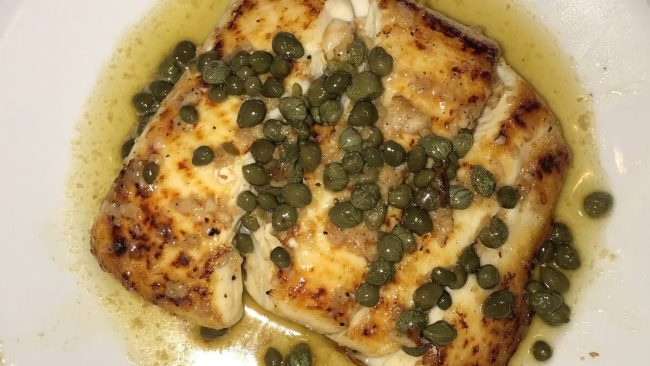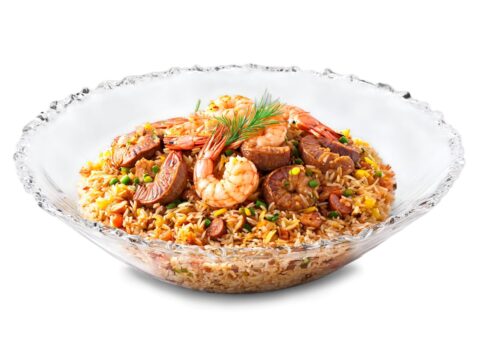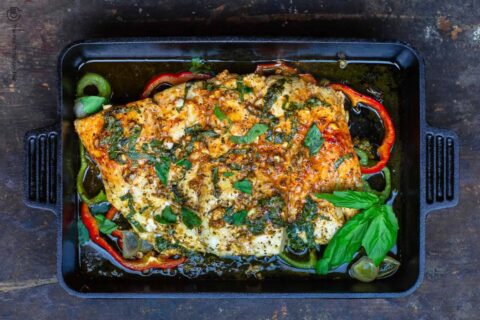
A 2020 study in the peer-reviewed Journal of American College of Cardiology (JACC) noted that higher fish consumption (as long as it’s not fried fish) has been associated with a reduced risk of heart failure and a drop in the incidence of metabolic syndrome, a cluster of conditions occurring together, raising your risk of heart disease, stroke and type 2 diabetes.
The Pesco-Mediterranean diet reduces your meat consumption, including red meat and processed meats, which are both “pro-inflammatory” and raise “bad” LDL (low-density lipoprotein) cholesterol levels. Red and processed meats are a significant source of saturated fat. Processed meats tend to be high in sodium and other additives that may dilute nutritional quality.
On the other hand, fish intake, often attributed to the healthier fats, have been shown to decrease coronary artery disease and sudden cardiac death and may also benefit other systems in our body such as brain health and lowering cancer risk.
Halibut is a species of flatfish, in fact, the Atlantic halibut is the largest flatfish in the world. The record for a halibut was broken off the waters of Norway in July 2013 by a 234-kilogram (515-pound), 2.62-metre (8-foot-7-inch) fish.
Halibut are dark brown on the top side with an off-white underbelly and have very small scales invisible to the naked eye embedded in their skin. Halibut are symmetrical at birth with one eye on each side of the head. Then, about six months later, one eye migrates to the other side of the head.
The eyes are permanently set once the skull is fully formed. At the same time, the stationary-eyed side darkens to match the top side, while the other side remains white. This colour scheme disguises halibut from above (blending with the ocean floor) and from below (blending into the light from the sky) and is known as countershading.
Halibut live at depths ranging from a few meters to hundreds of meters, and although they spend most of their time near the bottom, halibut may move up in the water column to feed. In most ecosystems, the halibut is near the top of the marine food chain.
Halibut yield large fillets from both sides of the fish, with the small round cheeks providing an additional source of meat.[11] Halibut are often boiled, deep-fried or grilled while fresh. Smoking is more difficult with halibut meat than it is with salmon, due to its ultra-low fat content. Eaten fresh, the meat has a clean taste and requires little seasoning. Halibut is noted for its dense and firm texture.
Rich In Micronutrients
Halibut is an excellent source of selenium, a trace mineral with many health benefits that your body needs in small amounts. A cooked half-filet (160 grams) of halibut, which is the recommended serving size, provides over 100% of your daily dietary needs. Selenium is a powerful antioxidant that helps your body repair damaged cells and can decrease inflammation. It also plays an important role in thyroid health.
In addition, halibut is a good source of a variety of other micronutrients that contribute to good health, including:
- Niacin: Niacin plays a positive role in heart health and even helps prevent heart disease. It can also protect your skin from sun damage. A half-filet (160 grams) of halibut provides 57% of your dietary needs.
- Phosphorus: The second most abundant mineral in your body, phosphorus helps build bones, regulates metabolism, maintains a regular heartbeat and more. A serving of halibut provides 45% of your dietary needs.
- Magnesium: Magnesium is required for more than 600 reactions in your body, including protein formation, muscle movements and energy creation. A serving of halibut provides 42% of your dietary needs.
- Vitamin B12: Vitamin B12 plays an essential role in red blood cell formation and proper nervous system function. It’s found naturally in animal foods. A half-filet (160 grams) of halibut provides 36% of your dietary needs.
- Vitamin B6: Also known as pyridoxine, vitamin B6 is involved in over 100 reactions in your body. It’s beneficial to the central nervous system and may boost brain function. Halibut provides 32% of your dietary needs.
A Wonderful Fish Dish For Extra Virgin Olive Oil
This is a very easy seared halibut with a buttery wine and caper sauce. It takes hardly any time at all to make, but it is sure to leave a lasting impression. We hope you try out this halibut and caper recipe.
Halibut Recipe with Capers and Olive Oil
Ingredients
- 1 tablespoon Morocco Gold extra virgin olive oil.
- 2 (8 ounce) steaks halibut
- ½ cup white wine
- 1 teaspoon chopped garlic
- ¼ cup butter
- Salt and pepper to taste
- 3 tablespoons capers, with liquid
Instructions
- Heat the olive oil in a large skillet over medium-high heat. Fry the halibut steaks on all sides until nicely browned. Remove from pan, and set aside.
- Pour the wine into the pan, and use a spatula to scrape any browned bits from the bottom. Let the wine reduce to almost nothing, then stir in the garlic, butter and capers. Season with salt and pepper to taste. Let the sauce simmer for a minute to blend the flavors.
- Return the steaks to the pan and coat them with sauce. Cook until fish flakes easily with a fork. Serve fish immediately with the sauce from the pan. Drizzle with Morocco Gold extra virgin olive oil.
- Enjoy the benefits of cooking this halibut and caper recipe.



